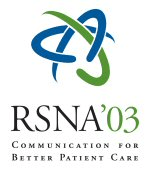Abstract:
HTML
Purpose: Normal adult cortical bone has a very short T2 and characteristically produces no signal with the pulse sequence echo times (TE's) routinely used in clinical practice. We wished to determine whether it was possible to detect signal from cortical bone using ultrashort TE (UTE) pulse sequences and use this signal to characterise this tissue in normal volunteers and patients.
Methods and Materials: Five volunteers and 10 patients were examined using ultrashort TE pulse sequences (TE = 0.07 or 0.08 msecs). Fat suppressed, long T2 suppressed and short and long inversion pulse versions were used as preparation pulses. Later echo images were also obtained as well as difference images produced by subtracting later echo images from the first echo images. Saturation pulses were used for T1 measurement and images with progressively increasing TE's for T2 measurement. Intravenous Gadodiamide was administered to four subjects.
Results: Signal could be detected with UTE sequences in normal adults and patients. This signal was usually made more obvious by subtracting a later echo from the first. Normal mean adult T1's ranged from 136 msec to 257 msec depending on age, and mean T2's ranged from 0.42 to 0.450 msec. Increased signal was observed after contrast enhancement in a normal volunteer and all three patients in whom it was administered. Changes in signal in short T2 components were seen in acute fractures and in new bone formation after malunion. In osteoporosis bone volume and signal were reduced.
Conclusion: Signal can be detected from cortical bone and this can be used to measure T1 and T2* as well as observe contrast enhancement. Difference images and short TI inversion recovery sequences were of value in increasing tissue conspicuity. Acute fractures showed decreased short T2 components. New bone formed after fracture showed an increase in signal from short T2 components.
Bydder MBChB, G,
Magnetic Resonance Imaging of Cortical Bone with Ultrashort TE (UTE) Pulse Sequences. Radiological Society of North America 2003 Scientific Assembly and Annual Meeting, November 30 - December 5, 2003 ,Chicago IL.
http://archive.rsna.org/2003/3102798.html

